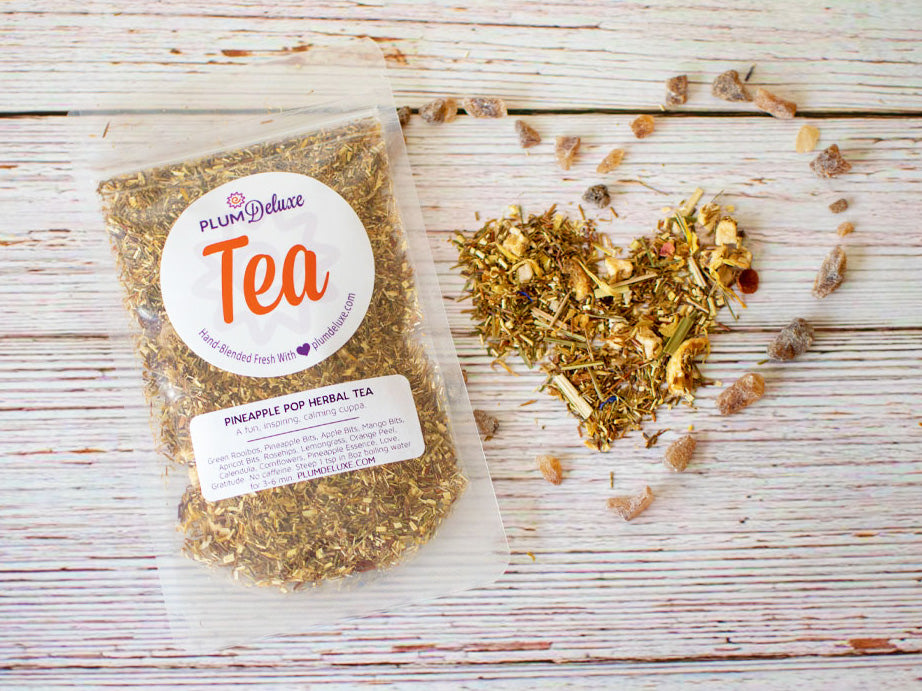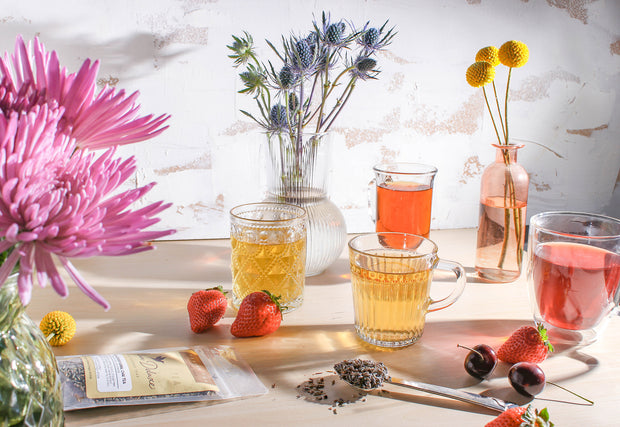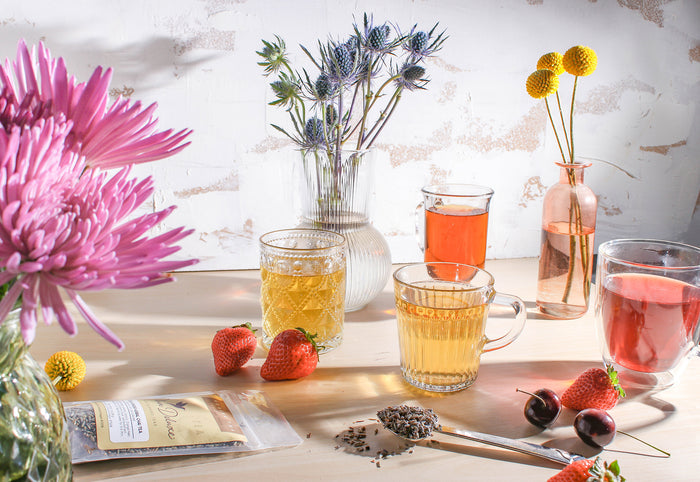Luckily, even the most acidic of teas, like berry and citrus blends, aren't nearly as acidic as sodas and fruit juices. Some tea, like green tea, can even be very alkaline.
So is tea acidic? And what makes a tea blend acidic? Let's find out!

Is Tea Acidic?
In general, most tea is mildly acidic, but the level of acidity depends on the type of tea leaves or the type of blend.
For instance, green tea is generally neutral to alkaline, while more oxidized tea (like black tea and darker oolong tea) is more acidic.
You’ll recognize acidic teas by their tart, punchy flavor – think strong breakfast tea flavored with orange rind and a little bit of lemon, or fruity tea with lots of berry pieces.
What Makes Tea Acidic?
The oxidation process makes tea leaves more acidic, so the more mature/processed tea is, the more acidic it will be, even before anything is added to it. Younger green and white tea leaves are neutral to alkaline, depending on how they were processed.
As for blends, the addition of various spices, citrus, and fruit can make a blend acidic. The most acidic tea blends are black tea blends with berries and rosehips, followed by citrus blends. Most herbal blends are neutral or very slightly acidic.
Longer steeping times can also affect how acidic a tea is, especially if it’s already fairly acidic. The longer you steep it, the more acidic the taste. (And depending on the tea, oversteeping can also make it very bitter!)
And, of course, adding sugar, fruit and citrus juices, milk, and other additions can change the acidity of your favorite cuppa.

Acidity in Tea vs Coffee and Other Drinks
On the pH scale, 7 is neutral. The lower the number, the more acidic a drink is. Higher levels indicate alkalinity.
Coffee has an average pH value of 4.85 to 5.10, making it (generally) more acidic than tea.
Sodas, vitamin waters, and other beverages typically have pH levels of less than 4, making them much more acidic than tea. Even most bottled tea tends to be pretty acidic.
Black tea has an average pH level of 4.9 to 5.5, and green tea tends to be neutral to alkaline. The only teas that are more acidic than coffee are citrus, rosehip, and berry blends, which have a pH level of 2 to 3.
Anything less than a 4 is typically thought to be damaging to your teeth, but you would have to drink highly acidic tea very frequently or hold it in your mouth for an extended period of time for it to do much damage to your teeth.

How to Reduce Acidity in Tea
To reduce acidity in tea, you just need to add something that’s more neutral to alkaline.
Adding milk can balance out teas that tend to be more acidic, particularly fruit teas. Or, if it’s a matter of the tea simply being a little too strong for your tastes, diluting it with neutral/alkaline water can help reduce acidity.
Keep in mind that if you’re worried about heartburn or acid reflux, milk might not always help. While it can help reduce the acidity of highly acidic teas, milk that has been processed or pasteurized and lacks a lot of its natural bacteria is a little more acidic than regular milk.
(It also depends on how your body reacts to milk. If you have a hard time digesting dairy, adding milk won’t be any easier on your stomach! Adding alkaline water would be a better way to reduce acidity.)
It is possible for some water to be acidic, so depending on what you add, it may not help to reduce the acidity of a drink. If you want to make sure, you can test the water that you normally use for tea with a pH tester kit.

Is Acidic Tea Bad for You?
Loose leaf tea isn’t acidic enough to be harmful, but too much of anything can be bad for you. Just as drinking too many acidic drinks can be harmful, so can drinking too many alkaline drinks. There needs to be a balance!
If you know you’re sensitive to acidic drinks, it’s better to stick to less acidic black tea blends and green tea. Hope Blend is a jasmine green tea without any sort of fruit pieces or additions, making it a neutral tea.
If you just like to enjoy a few cups of tea every day, you shouldn’t have to worry about how acidic your tea is. Typically, tea companies that make their own blends look for ways to balance out tart, fruity blends.
For instance, you’ll see that many fruit and citrus blends have a green tea base to help balance out the acidity and tartness of what could be an overwhelmingly tart blend. (Blends like Pineapple Pop would generally be pretty acidic, but the green tea blend balances things out!)
And while there are many black tea blends with citrus and fruit pieces, you’ll notice there typically isn’t as much fruit when compared to herbal and green tea blends.
You may think that spicy blends might be acidic, but the only thing that adds much acidity is the citrus pieces, like in Rainy Day Pu-erh. Black tea tends to be only lightly acidic and spices don’t add acidity, making this a very low-acid tea.

In general, tea has many other benefits that far outweigh the impact of a little acidity (like the presence of many helpful antioxidants and lack of additives that you find in many sodas and other ready-to-drink beverages).
Even if you’re someone who likes to be a bit more cautious, reputable companies have a complete list of all the ingredients in each of their tea blends. You can just look for things you’d like to have in moderation and find a good balance of different ingredients.
Loose leaf tea certainly has more beneficial effects that make it a healthy choice of beverage, even if you’re drinking on a regular basis. So you can safely enjoy your favorite cuppa without having to worry about potential downsides!

![Spring Break Tea Variety Pack [6-Pack Variety of Flavors]](http://www.plumdeluxe.com/cdn/shop/files/spring-break-pack.jpg?v=1740682266&width=165)















